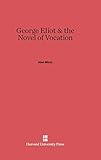George Eliot and the Novel of Vocation / Alan Mintz.
Material type: TextPublisher: Cambridge, MA : Harvard University Press, [2013]Copyright date: ©1978Edition: Reprint 2014Description: 1 online resource (193 p.)Content type:
TextPublisher: Cambridge, MA : Harvard University Press, [2013]Copyright date: ©1978Edition: Reprint 2014Description: 1 online resource (193 p.)Content type: - 9780674428553
- 9780674428560
- 823/.8
- online - DeGruyter
| Item type | Current library | Call number | URL | Status | Notes | Barcode | |
|---|---|---|---|---|---|---|---|
 eBook
eBook
|
Biblioteca "Angelicum" Pont. Univ. S.Tommaso d'Aquino Nuvola online | online - DeGruyter (Browse shelf(Opens below)) | Online access | Not for loan (Accesso limitato) | Accesso per gli utenti autorizzati / Access for authorized users | (dgr)9780674428560 |
Browsing Biblioteca "Angelicum" Pont. Univ. S.Tommaso d'Aquino shelves, Shelving location: Nuvola online Close shelf browser (Hides shelf browser)

|

|

|

|

|

|

|
||
| online - DeGruyter The Modern Supreme Court / | online - DeGruyter The American Ethos : Public Attitudes toward Capitalism and Democracy / | online - DeGruyter The Challenge to American Foreign Policy / | online - DeGruyter George Eliot and the Novel of Vocation / | online - DeGruyter The Dangerous Class : Crime and Poverty in Columbus, Ohio, 1860–1885 / | online - DeGruyter Kipling and Conrad : The Colonial Fiction / | online - DeGruyter Dangerous Offenders : The Elusive Target of Justice / |
Frontmatter -- PREFACE -- CONTENTS -- 1. IDEAS AND INSTITUTIONS -- 2. THE SHAPE OF A LIFE IN BIOGRAPHY AND AUTOBIOGRAPHY -- 3. MIDDLEMARCH: THE ROMANCE OF VOCATION -- 4. MIDDLEMARCH: ORIGINS AND TAXONOMY -- 5. MIDDLEMARCH: INDIRECTION AND IDENTIFICATION -- 6. MIDDLEMARCH: CHOICE AND EVASION -- 7. DANIEL DERONDA AND THE MESSIANIC CALLING -- 8. EPILOGUE: THE CRAFT OF SOCIETY AND THE VOCATION OF ART -- NOTES -- INDEX
restricted access online access with authorization star
http://purl.org/coar/access_right/c_16ec
Mintz has discovered a new sub-genre of fiction: the novel of vocation. In the nineteenth century, he maintains, work ceased to be merely what one did for a living or out of a sense of duty and became a vehicle for self-definition and self-realization. The change was prepared for by the growth of professions and the increase in middle-class career opportunities, He shows how George Eliot, in particular, linked these new social possibilities to the older Puritan doctrine of calling or vocation, achieving in her late novels a fictional structure that could encompass the conflicting energies of the age. In the idea of vocation she found a way to explore how far it is possible to be ambitious both for oneself and for a large cause, and a way to probe the contradictions between ambitious, self-defining work and the older institutions; of family, community, and religion. The book is solidly grounded in cultural and historical reality. Although Mintz concentrate on George Eliot and especially Middlemarch, he also examines the conceptions of self and work in Victorian biographies and autobiographies and the emergence in late-nineteenth-century fiction of the idea of the vocation of art.
Mode of access: Internet via World Wide Web.
In English.
Description based on online resource; title from PDF title page (publisher's Web site, viewed 29. Nov 2021)


